
The Metropolitan Area Express (MAX) is a light rail system serving the Portland metropolitan area in the U.S. state of Oregon. Owned and operated by TriMet, it consists of five lines connecting the six sections of Portland; the communities of Beaverton, Clackamas, Gresham, Hillsboro, Milwaukie, and Oak Grove; and Portland International Airport to Portland City Center. Trains run seven days a week with headways of between 30 minutes off-peak and three minutes during rush hours. In 2019, MAX had an average daily ridership of 120,900, or 38.8 million annually. Due to the COVID-19 pandemic, which impacted public transit use globally, annual ridership plummeted, with only 14.8 million riders recorded in 2021.
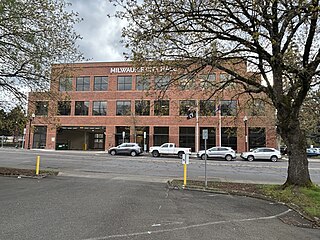
Milwaukie is a city mostly in Clackamas County, Oregon, United States; a very small portion of the city extends into Multnomah County. The population was 21,119 at the 2020 census. Founded in 1847 on the banks of the Willamette River, the city, known as the Dogwood City of the West, was incorporated in 1903 and is the birthplace of the Bing cherry. The city is now a suburb of Portland and also adjoins the unincorporated areas of Clackamas and Oak Grove.

The Portland Streetcar is a streetcar system in Portland, Oregon, that opened in 2001 and serves areas surrounding downtown Portland. The 3.9-mile (6.3 km) NS Line runs from Northwest Portland to the South Waterfront via Downtown and the Pearl District. The Loop Service, which opened in September 2012 as the Central Loop, runs from Downtown to the Oregon Museum of Science and Industry via the Pearl District, the Broadway Bridge across Willamette River, the Lloyd District, and the Central Eastside Industrial District and added 3.3 miles (5.3 km) of route. In September 2015 the line was renamed as the Loop Service, with the A Loop traveling clockwise, and the B Loop traveling counterclockwise. The two-route system serves some 20,000 daily riders.

The Tri-County Metropolitan Transportation District of Oregon (TriMet) is a transit agency that serves most of the Oregon part of the Portland metropolitan area. Created in 1969 by the Oregon legislature, the district replaced five private bus companies that operated in the three counties: Multnomah, Washington, and Clackamas. TriMet began operating a light rail system, MAX, in 1986, which has since been expanded to five lines that now cover 59.7 miles (96.1 km). It also operates the WES Commuter Rail line since 2009. It also provides the operators and maintenance personnel for the city of Portland-owned Portland Streetcar system. In 2023, the system had a ridership of 62,055,600, or about 196,000 per weekday as of the first quarter of 2024.
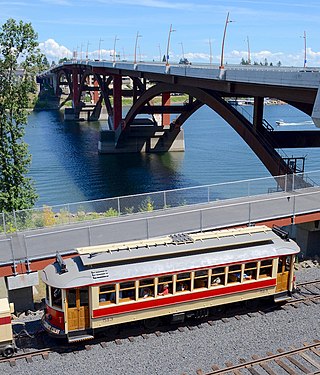
The Willamette Shore Trolley is a heritage railroad or heritage streetcar that operates along the west bank of the Willamette River between Portland and Lake Oswego in the U.S. state of Oregon. The right-of-way is owned by a group of local-area governments who purchased it in 1988 in order to preserve it for potential future rail transit. Streetcar excursion service began operating on a trial basis in 1987, lasting about three months, and regular operation on a long-term basis began in 1990. The Oregon Electric Railway Historical Society has been the line's operator since 1995.
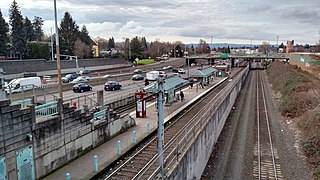
Hollywood/Northeast 42nd Avenue Transit Center, also known as Hollywood Transit Center, is a light rail station in the MAX Light Rail system and a bus transit center, located in the Hollywood District of Portland, Oregon. Hollywood/NE 42nd Ave is the 11th stop eastbound on the eastside MAX main line, and is served by the Blue, Green and Red Lines. The transit center's bus area, served by three routes, is temporarily closed for construction.

Like transportation in the rest of the United States, the primary mode of local transportation in Portland, Oregon is the automobile. Metro, the metropolitan area's regional government, has a regional master plan in which transit-oriented development plays a major role. This approach, part of the new urbanism, promotes mixed-use and high-density development around light rail stops and transit centers, and the investment of the metropolitan area's share of federal tax dollars into multiple modes of transportation. In the United States, this focus is atypical in an era when automobile use led many areas to neglect their core cities in favor of development along interstate highways, in suburbs, and satellite cities.
Portland is "an international pioneer in transit orientated developments."

The Sunset Transit Center is a TriMet bus transit center and light rail station on the MAX Blue and Red lines in Beaverton, Oregon. It opened for MAX in 1998 and is the 5th stop westbound on the Westside MAX. This is the first stop after the Robertson Tunnel under Portland's West Hills. Sunset TC is the second-busiest station on the Westside MAX line, with a weekday average of almost 6,000 daily riders in 2012. Though the station has a Portland address, it primarily serves residents of the communities of Cedar Hills, Cedar Mill, and Beaverton.
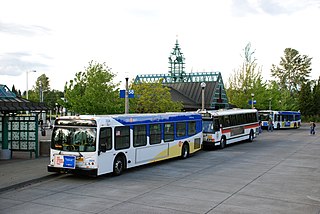
Beaverton Transit Center is a multimodal transport hub in Beaverton, Oregon, United States. Owned and operated by TriMet, it is served by bus, commuter rail, and light rail. The transit center is MAX Light Rail's 15th station eastbound on the Blue Line and western terminus on the Red Line. It is also the northern terminus of WES Commuter Rail and a hub for bus routes mostly serving the westside communities of the Portland metropolitan area. Beaverton Transit Center is situated on Southwest Lombard Avenue, just north of Southwest Canyon Road in central Beaverton, connected by walkway to Canyon Place Shopping Center. It recorded 9,709 average weekday boardings for all modes in fall 2018, making it TriMet's busiest transit center.
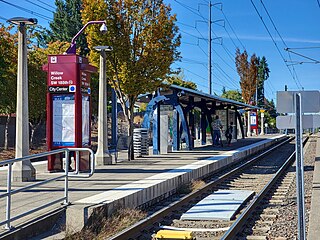
Willow Creek/Southwest 185th Avenue Transit Center is a multimodal transport hub in Hillsboro, Oregon, United States. Owned and operated by TriMet, it is served by bus and light rail. The transit center is the ninth station eastbound on the Blue Line and a hub for bus routes mostly serving Washington County in the Portland metropolitan area. It is located by the intersection of Southwest Baseline Road and 185th Avenue near the city's boundary with Beaverton.

The MAX Green Line is a light rail service in Portland, Oregon, United States, operated by TriMet as part of the MAX Light Rail system. It is 15 miles (24.1 km) long and serves 30 stations from the PSU South stations to Clackamas Town Center Transit Center; it connects Portland State University (PSU), Portland City Center, Northeast Portland, Southeast Portland, and Clackamas. The Green Line is the only service that shares parts of its route with the four other MAX services, sharing the Portland Transit Mall with the Orange and Yellow lines and the Banfield segment of the Eastside MAX with the Blue and Red lines. Southbound from Gateway/Northeast 99th Avenue Transit Center, it operates the Interstate 205 (I-205) segment through to Clackamas Town Center. Service runs for approximately 211⁄2 hours daily with a headway of 15 minutes during most of the day. It is the third-busiest line in the system, carrying an average of 19,160 riders per day on weekdays in September 2019.

The Westside Express Service (WES) is a commuter rail line in the U.S. state of Oregon serving parts of Washington and Clackamas counties in the Portland metropolitan area. Owned by TriMet and operated by Portland & Western Railroad (P&W), the line is 14.7 miles (23.7 km) long and travels north–south from Beaverton to Wilsonville along a route just west of Oregon Highway 217 and Interstate 5 (I-5). WES consists of five stations and connects with MAX Light Rail at Beaverton Transit Center. Service operates on a 45-minute headway on weekdays during the morning and evening rush hours. In Spring 2022, WES saw a daily ridership of 420 passengers or about 109,000 riders annually.

The Clackamas Town Center Transit Center is a bus transit center and MAX Light Rail station, located in Clackamas County, Oregon, in the southeastern part of the Portland metropolitan area. Clackamas Town Center TC is the southern terminus of the MAX Green Line, which began service in 2009.
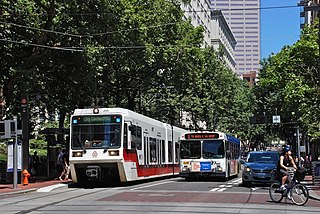
The Portland Transit Mall is a 1.2-mile (1.9 km) public transit corridor that travels north–south through the center of downtown in Portland, Oregon, United States. It comprises a pair of one-way streets—6th Avenue for northbound traffic and 5th Avenue for southbound—along which two of three lanes are restricted to transit buses and light rail vehicles only. As of September 2022, the corridor is served by the Green, Orange, and Yellow lines of MAX Light Rail; Frequent Express; and over a dozen local bus routes, all of which are services of TriMet, the transit agency operating within the Oregon side of the Portland metropolitan area. C-Tran, the transit agency for Clark County, Washington, additionally serves it with two express bus routes—#105 I-5 Express and #164 Fisher’s Landing Express.

Wilsonville Transit Center, also called SMART Central at Wilsonville Station, is a bus and commuter rail transport hub in Wilsonville, Oregon, United States. The transit center, which is owned and operated by the City of Wilsonville, is the hub for the South Metro Area Regional Transit (SMART) bus system. The Portland metropolitan area's regional transit agency, TriMet, operates the southern terminus of its WES Commuter Rail at the facility; WES connects with the Blue and Red lines of MAX Light Rail at Beaverton Transit Center. Opened in January 2009, the transit center includes a 400-car park and ride.

Tigard Transit Center, formally Thomas M. Brian Tigard Transit Center, is a transport hub in Tigard, Oregon, United States, that is owned and operated by TriMet. It is a transfer facility for bus routes mainly serving the westside communities of the Portland metropolitan area and the third southbound station from Beaverton Transit Center on WES Commuter Rail. The transit center is the located in downtown Tigard just south of Oregon Route 99W on Commercial Street. It recorded 1,627 average weekday boardings in fall 2019. The facility opened in 1988 as a bus transit center, and a platform for WES was added in 2009.

Hall/Nimbus is a train station in Beaverton, Oregon, United States, served by TriMet as part of WES Commuter Rail. It is the second station southbound on the commuter rail line, which runs between Beaverton and Wilsonville in the Portland metropolitan area's Washington County. Opened in February 2009, the TriMet-owned station is located west of Oregon Route 217 near the Washington Square shopping mall on Hall Boulevard. It includes a 50-car park and ride and connections to TriMet bus routes 76–Hall/Greenburg and 78–Beaverton/Lake Oswego. WES connects with the Blue and Red lines of MAX Light Rail at Beaverton Transit Center.

The Blue Bus lines were a group of four affiliated privately owned companies that provided bus transit service in the Portland, Oregon metropolitan area in the 1950s and 1960s. The name was unofficial – no company using this or similar name existed in the Portland area – but was in common use in the 1960s, and variations included "Blue Bus lines", "Blue Lines", "blue bus" lines and "blue buses". The Blue Bus companies provided service only between Portland and suburbs outside the city, or within such suburbs, as transit service within the city of Portland was the exclusive franchise of the Portland Traction Company or, after 1956, the Rose City Transit Company (RCT). The "blue buses" were prohibited from making stops inside the city except to pick up passengers destined for points outside RCT's service area. The "blue" name was a reference to the paint scheme worn by most buses of the consortium. By contrast, city transit operator Rose City's buses wore a primarily red paint scheme.

The TriMet transit system, serving the Portland metropolitan area in Oregon, owns and operates two different rail transit systems: a light rail system known as MAX, and a commuter rail system known as WES. The fleet of 145 MAX electric light rail vehicles (LRVs) includes five different models, designated by TriMet as "Type 1" through "Type 6". All types are used on all of the MAX lines, but the Type 6 cars – which will gradually replace the Type 1 cars – are still being delivered and have not yet begun to enter service. The comparatively very small WES fleet includes three different types of diesel commuter rail cars.



















